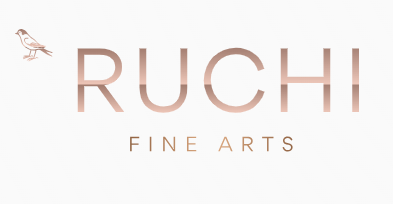In order to get a clear sense of what ink painting is about, I am going to explain the difference between Japanese ink painting and European painting.
The aim of classic Western painting is to depict the world and its objects as realistically as possible. For a three-dimensional effect. It needs a precise structure composed of a foreground, a background and a central object, as well as light, shadow and, above all, colour.

Traditional ink painting needs none of these aids. Even though it too depicts a precise view of the world, its goal is not to produce a realistic reproduction, but rather an expression that the painter wants to convey. Ink painting is an attempt to capture, in a condensed form, the essence of an object, a person, an animal or a landscape together with the spiritual processes within the artist. Which is why ‘suggestion’ plays a key role. Suggestion and simplification convey reality in a painting.
Japanese ink painting combines the traditional aesthetic of simplicity with a distinct emphasis on intuitive expression. A sense of harmony pervades every scene. This explains why paintings of flowers, birds and landscapes are so popular.
This style of painting, heavily influenced by Zen Buddhism, uses only blank ink. However according to Oriental understanding, black ink is not simply black – it contains every colour. It also represents the highest level of colour simplification.
Different degrees in tone do not represent different shades of light or brightness as they do in Europe; rather, they produce an awareness of colour by creating a contrast with the white space. This is what gives the painting the appearance of colour. The tones also serve as a direct expression of emotion, and they mirror the intensity of the painter’s interest. So this form of painting has an expressive character.
Differences between Chinese and Japanese ink painting
The roots of Japanese ink painting go back to 14th century. They came from China where two different styles already existed that, like Zen and the southern style, were brought to Japan. The Japanese aesthetic sensibilities are evident in these and later expressions. Although stylised Chinese ink paintings are most definitely not realistic representations of nature, like a photograph, they are very naturalistic studies of nature. However, this kind of painting has an underlying concept a desire for idealisation that does not allow the depiction of a problem. As when a painter expresses in works many of the theories and principles that are to be adhered to when creating a painting, and which have been handed down to us. They are extremely common in Chinese painting; in contrast, in Japanese painting, observations are much more influenced by feelings. Chinese ink painters prefer a more objective, logical depiction and admire the clarity expressed in dynamic lines. If something is meant to be hidden, it is often shown in symbols. Japanese ink painters often use symbolism or suggestive nuances of mood.
THE FOUR GENTLEMEN OF SUMI-E ART
Sumi-e (Japanese) or shuimo (Chinese) quick stroke painting is based on Chinese calligraphy and was brought to Japan by Chinese Zen Buddhist monks. The Four Gentlemen are bamboo, orchid, chrysanthemum, and plum. They represent the four seasons and are traditionally the foundational subjects for those studying Asian brush painting.
Bamboo
Symbolizing summer, vigorous growth, and upright posture and integrity, bamboo combines strength and beauty. Artists new to sumi-e begin by studying bamboo, a subject that will continue to challenge and inspire them decades later. Some artists even spend their whole careers painting nothing but bamboo in black ink. A painting of just a few leaves and stem can evoke a sense of nature and may be used to convey your emotions. A bamboo stick is often compared to life. Each segment of the woody stem has a distinct beginning and end, just like the ‘hellos’ and ‘goodbyes’ in life you could say. Life continues on a nodule. In Japanese, the word ‘nodule’ is written with the symbol for ‘moderation’. A lack of moderation makes life difficult.
Plum
In sumi-e painting, the plum is the symbol of winter, tenacity, and rugged perseverance in the face of hardship. Carve the old branches into paper, then add new branches and tender blossoms to represent the promise of new life and inner beauty despite adversity. Study of plum creates a bridge between floral painting and the study of trees for landscape painting.
Chrysanthemum
The chrysanthemum is the symbol of autumn and braving the frost, as well as moving forward and blooming despite fear.
Orchid
The orchid represents spring, hope, and new beginnings. As you paint the orchid, keep the brush vertical, but also develop curved, wavy leaves and sweet, delicate flowers.



youtube downloader says:
Thank you for sharing this insightful article! I found the information really useful and thought-provoking. Your writing style is engaging, and it made the topic much easier to understand. Looking forward to reading more of your posts!
Sarea Srivastava says:
Wow Ruchi!!!!!!